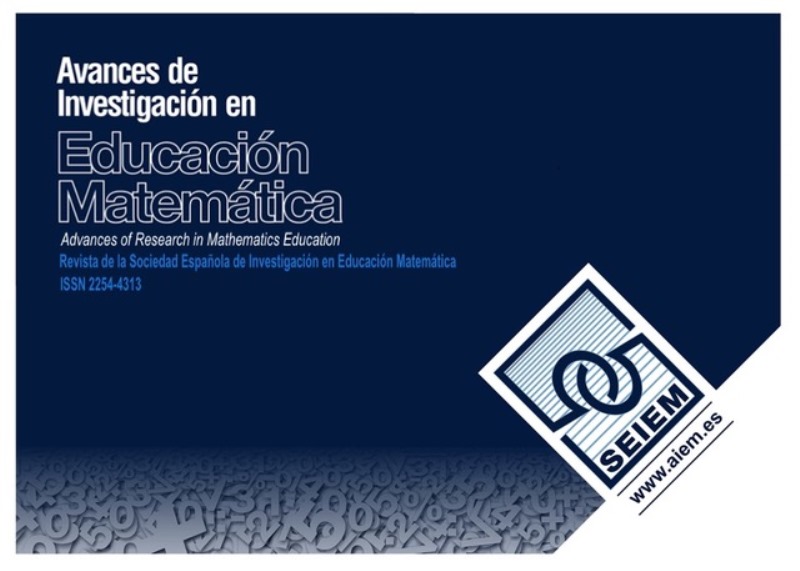La importancia de la formulación de problemas en el desarrollo de conocimiento matemático
DOI:
https://doi.org/10.35763/aiem28.8495Palabras clave:
Formulación de problemas, Enseñanza y aprendizaje de las matemáticas, Formación de profesoresResumen
La invención de problemas en matemáticas ha sido considerada, durante varias décadas, una herramienta de investigación y una estrategia de enseñanza y aprendizaje, no solo con estudiantes de diferentes niveles educativos, sino también con profesores en formación y en ejercicio. A través de los artículos de este monográfico se pone de manifiesto que la investigación sobre la creación de problemas está adquiriendo un papel cada vez más relevante en la Educación Matemática. La diversidad de perspectivas y referentes teóricos que sostienen las investigaciones sobre formulación de problemas, así como los objetivos que se abordan, muestra una visión amplia que puede resultar de interés para la comunidad investigadora en un ámbito internacional, con un foco especial en estudios realizados en España.
Descargas
Citas
Arteaga, P., Batanero, C., Contreras, J. M., & Cañadas, G. R. (2015). Statistical graphs complexity and reading levels: A study with prospective teachers. Statistique et Enseignement, 6(1), 3–23. https://doi.org/10.3406/staso.2015.1301
Ayllón, M. F., Gallego, J. L., & Gómez, I. A. (2016). La actuación de estudiantes de educación primaria en un proceso de invención de problemas. Perfiles Educativos, 38(152), 51–67. https://doi.org/10.22201/iisue.24486167e.2016.152.57588
Baumanns, L., & Rott, B. (2021). Rethinking problem-posing situations: A review. Investigations in Mathematics Learning, 13(2), 59–76. https://doi.org/10.1080/19477503.2020.1841501
Cai, J., & Hwang, S. (2020). Learning to teach through mathematical problem posing: Theoretical considerations, methodology, and directions for future research. International Journal of Educational Research, 102, 101420. https://doi.org/10.1016/j.ijer.2019.01.001
Cai, J., Hwang, S., Jiang, C., & Silber, S. (2015). Problem posing research in mathematics: Some answered and unanswered questions. En F. M. Singer, N. Ellerton & J. Cai (Eds.), Problem posing: From research to effective practice (pp. 3-34). Springer.
Cai, J., Koichu, B., Rott, B., Zazkis, R., & Jiang, C. (2022). Mathematical problem posing: Tasks variables, processes, and products. En C. Fernández, S. Llinares, A. Gutiérrez, & N. Planas (Eds.), Proceedings of the 45th Conference of the International Group for the Psychology of Mathematics Education (Vol. 1, pp. 119–145). PME.
Cai, J., & Rott, B. (2024). On understanding mathematical problem-posing processes. ZDM – Mathematics Education, 56, 61–71.
https://doi.org/10.1007/s11858-023-01536-w
Einarsson, H., Lund, S. H., & Jónsdóttir, A. H. (2024). Application of ChatGPT for automated problem reframing across academic domains. Computers and Education: Artificial Intelligence, 6, 100194. https://doi.org/10.1016/j.caeai.2023.100194
Embid, S., & Perdomo-Díaz, J. (2024). Evaluación del potencial de distintos chatbots para la formulación de problemas matemáticos. Formación del Profesorado e Investigación en Educación Matemática, 16, 41–58.
Erdogan, F. (2020). Prospective middle school mathematics teacher’s problem posing abilities in context of Van Hiele levels of geometric thinking. International Online Journal of Educational Sciences, 12(2), 132–152. https://doi.org/10.15345/iojes.2020.02.009
Fernández, M. E., & Carrillo, J. (2020). Un acercamiento a la forma en que los estudiantes de primaria formulan problemas. Revista de Educação Matemática, 17, 1–19. https://doi.org/10.37001/remat25269062v17id257
Godino, J. D. (2024). Enfoque ontosemiótico en educación matemática. Fundamentos, herramientas y aplicaciones. Aula Magna.
Guo, Y., Yan, J., & Men, T. (2021). Chinese junior high school students’ mathematical problem-posing performance. ZDM – Mathematics Education, 53, 905–917. https://doi.org/10.1007/s11858-021-01240-7
Hartmann, L. M., Krawitz, J., & Schukajlow, S. (2023). Posing and solving modelling problems—extending the modelling process from a problem posing perspective. Journal für Mathematik-Didaktik, 44(2), 533–561. https://doi.org/10.1007/s13138-023-00223-3
Leavy, A., & Hourigan, M. (2022). The framework for posing elementary mathematics problems (F-PosE): Supporting teachers to evaluate and select problems for use in elementary mathematics. Educational Studies in Mathematics, 111, 147–176. https://doi.org/10.1007/s10649-022-10155-3
Leikin, R., & Elgrably, H. (2020). Problem posing through investigations for the development and evaluation of proof-related skills and creativity skills of prospective high school mathematics teachers. International Journal of Educational Research, 102, 101424. https://doi.org/10.1016/j.ijer.2019.04.002
Malaspina, U. (2021). Creación de problemas y de juegos para el aprendizaje de las matemáticas. Edma 0-6: Educación Matemática en la Infancia, 10(1), 1–17. https://doi.org/10.24197/edmain.1.2021.1-17
Malaspina, U., Torres, C., & Rubio, N. (2019). How to stimulate in-service teachers’ didactic analysis competence by means of problem posing. En P. Liljedahl & L. Santos-Trigo (Eds.), Mathematical Problem Solving (pp. 133–151). Springer. https://doi.org/10.1007/978-3-030-10472-6_7
Mallart, A., Font, V., & Diez, J. (2018). Case study on mathematics pre-service teachers’ difficulties in problem posing. Eurasia Journal of Mathematics, Science and Technology Education, 14(4), 1465–1481. https://doi.org/10.29333/ejmste/83682
Santos-Trigo, M. (2024). Problem solving in mathematics education: tracing its foundations and current research-practice trends. ZDM – Mathematics Education, 56, 211-222. https://doi.org/10.1007/s11858-024-01578-8
Silber, S., & Cai, J. (2021). Exploring underprepared undergraduate students’ mathematical problem posing. ZDM – Mathematics Education, 53, 877–889. https://doi.org/10.1007/s11858-021-01272-z
Singer, F., Ellerton, N., & Cai, J. (2013). Problem-posing research in mathematics education: New questions and directions. Educational Studies in Mathematics, 83(1), 1–7. https://doi.org/10.1007/s10649-013-9478-2
van Oers, B. (2024). The development of mathematical thinking in young children’s play: The role of communicative tools. En H. Palmér, C. Björklund, E. Reikerås, & J. Elofsson (Eds.), Teaching Mathematics as to be Meaningful – Foregrounding Play and Children’s Perspectives. Springer.
https://doi.org/10.1007/978-3-031-37663-4_1
Wilkie, K. J. (2024). Creative thinking for learning algebra: Year 10 students’ problem solving and problem posing with quadratic figural patterns. Thinking Skills and Creativity, 52, 101550. https://doi.org/10.1016/j.tsc.2024.101550
Wilson, L. O. (2016). Anderson and Krathwohl Bloom’s taxonomy revised: Understanding the new version of Bloom’s taxonomy. The Second Principle, 1(1), 1–8.
Yao, Y., Hwang, S., & Cai, J. (2021). Preservice teachers’ mathematical understanding exhibited in problem posing and problem solving. ZDM – Mathematics Education, 53, 937–949. https://doi.org/10.1007/s11858-021-01277-8
Zhang, C., Zhou, Y., Wijaya, T. T., Chen, J., & Ning, Y. (2024). Effects of a problem posing instructional interventions on student learning outcomes: A three-level meta-analysis. Thinking Skills and Creativity, 53, 101587. https://doi.org/10.1016/j.tsc.2024.101587
Descargas
Publicado
Cómo citar
Número
Sección
Licencia
Derechos de autor 2025 María Burgos , Alicia Bruno

Esta obra está bajo una licencia internacional Creative Commons Atribución 4.0.
Los trabajos se publican bajo una licencia de Creative Commons: Reconocimiento 4.0 España a partir del número 21 (2022).
Los autores que publican en esta revista están de acuerdo con los siguientes términos:
- Los autores conservan los derechos de autor y el reconocimiento de la autoría.
- Los textos publicados en esta revista están sujetos –si no se indica lo contrario– a una licencia de Reconocimiento 4.0 Internacional de Creative Commons. Puede copiarlos, distribuirlos, comunicarlos públicamente, hacer obras derivadas y usos comerciales siempre que reconozca los créditos de las obras (autoría, nombre de la revista, institución editora) de la manera especificada por los autores o por la revista. La licencia completa se puede consultar en http://creativecommons.org/licenses/by/4.0.
- Los autores pueden establecer por separado acuerdos adicionales para la distribución no exclusiva de la versión de la obra publicada en la revista (por ejemplo, situarlo en un repositorio institucional o publicarlo en un libro), con un reconocimiento de su publicación inicial en esta revista.
- Se permite y se anima a los autores a difundir sus trabajos electrónicamente (por ejemplo, en repositorios institucionales o en su propio sitio web) antes y durante el proceso de envío, ya que puede dar lugar a intercambios productivos, así como a una citación más temprana y mayor de los trabajos publicados (Véase The Effect of Open Access) (en inglés).
Datos de los fondos
-
Agencia Estatal de Investigación
Números de la subvención PID2022-139748NB-100 -
Agencia Estatal de Investigación
Números de la subvención PID2022-139007NB-I00









